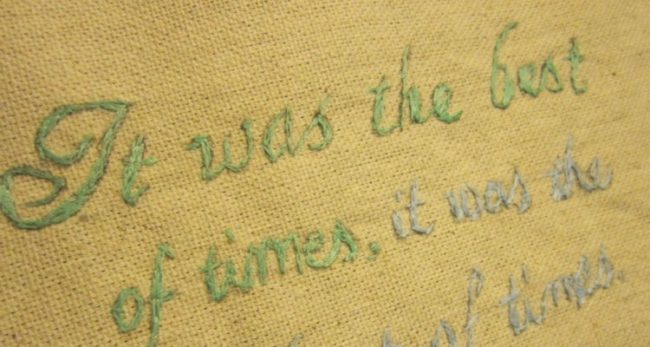07.06.17John Costello’s New Art of the Sentence Insights

A well-wrought sentence is a powerful thing
Yesterday I shared Maggie Johnson’s thoughts about a great bit of writing instruction in Gabby Woolf’s classroom. The connection to the amazing sentence-development work of Judith Hochman also struck my colleague John Costello. He reflects further on it in this guest post:
Here at TLaC towers we love observing teachers who focus on sentence-craft to build the core writing skill of sentence fluency—i.e. ‘syntactic control.’ For example we’ve always loved Judith Hochman’s sentence expansion activities and the way they challenge students to complete sentences with a variety of coordinating conjunctions in a content rich setting.
Hochman suggests asking students to expand a sentence, for example, ‘A solid melts to form a liquid’ three different ways, using but, because and so to develop the idea further.
As in:
- A solid melts to form a liquid, but it can also sometimes sublimate to form a gas.
- A solid melts to form a liquid because heat or pressure causes the ordering of molecules to break down.
- A solid melts to form a liquid so a glacier is really water waiting to happen.
The rigor of the sentence, Hochman notes, comes from the content. When you are immersed in it your sentence is full of ideas.
TLaC’s own Art of the Sentence technique discusses a similar idea, carefully crafting and recrafting a single sentence often using a ‘sentence starter,’ or sentence parameters. The idea is that we can improve the quality of student writing by breaking down, scaffolding and practicing the discrete skills of sentence development, and all the while providing students with handy exemplars of valuable words and phrases.
You can probably imagine a variety of useful parameters that could help students develop complex sentences. For instance, if students were having trouble varying the length of their sentences, you could have them practice merging separate statements.
I’ve always tried to keep an eye out for new ways to use parameters in service of Art of the Sentence, so like my colleague Maggie Johnson I was excited to see a great application during a recent video review session. Having previously worked with students to develop topic sentences and marshal evidence, King Solomon Academy’s Gabby Woolf, set up a writing activity to help students develop quality concluding statements.
She started by writing an exemplar paragraph:
Stevenson uses violent and brutal language to describe the murder, which sensationalizes the crime, particularly to a Victorian reader. Apparently unprovoked, Hyde “broke out into a great flame of anger, stamping with his foot, brandishing the cane like a madman.” The metaphor “flame of anger” portrays Hyde’s erratic and impulsive responses, like that of a wild animal, and the brutal verb “stamping” links to the action of an enraged degenerate. Using all of his bodily force to cause harm, the brandishing of his cane portrays the excitement with which he holds his weapon gleefully in his killing of the MP.
Then she asked her students to write the concluding sentence to the paragraph. Not only did this place the sentence in the ‘content rich setting’ Hochman emphasizes, but it caused students to have to craft a sentence that fit meaningfully into the structure of a larger paragraph- an inferred sentence parameter.
I was really struck by this. I was so used to looking within a sentence for parameter constraints (asking students to start with a specific phrase, or making sure they include a key coordinating conjunction), it was a welcome surprise to witness how teachers could utilize external parameters, like incomplete paragraphs.
The unit of analysis was still small – a humble sentence, the building-block of writing – but now students had to configure their sentence so it fit meaningfully into the larger paragraph. Further, paragraph completion is fairly modular; this activity could be used just as effectively to practice writing topic sentences or supporting statements.
As it’s always a joy to study great teaching, I’m looking forward to learning even more about AOS and parameter constraints from all the champion teachers out there.

I’m intrigued by this new twist on Art of the Sentence-style writing (which I’ve adapted from TLaC and Reading Reconsidered and use extensively with high-school English classes), yet I wonder if the example above involves *enough* parameters.
Students often struggle with writing effective and appropriate conclusions, so it strikes me as a really prime spot for practice, but I think I might want to stipulate some further criteria to help guide them in completing the Mr. Hyde paragraph. Otherwise, I would worry that they might practice writing a conclusion without really being any more effective or successful at it.
(I’m hopeful that Hochman and Wexler’s upcoming The Writing Revolution will contain good tips for composing concluding sentences and conclusion paragraphs.)
Hi, Mark- Thanks for your comment. Good questions all around. My gut would be that it would be beneficial to support this by Show Calling a few answers to identify effective models and then ask students to revise. But of course that doesn’t fully eliminate the risks of poor practice. Best, Doug
Good point. Show Calling to highlight solid and effective responses seems like a good step that should improve students’ practice. Appreciated!